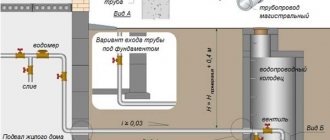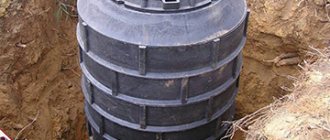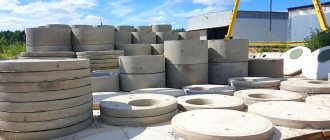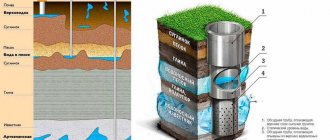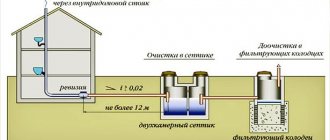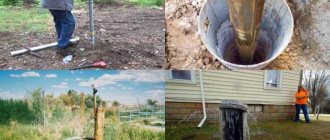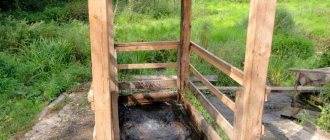What are the differences between a well and wells?
The first way these two hydraulic structures differ from each other is their depth. Wells are usually dug to a depth of 15 m. There is no point anymore, because it is at this depth that aquifers often lie.
The well is much deeper. Sometimes it is necessary to drill a hole up to 200 m deep to get to clean water. Therefore, it is considered that all hydraulic structures with a depth of more than 15 m are classified as wells.
But that's not all. Wells have been known to people since ancient times. They were usually dug out by hand, which is still practiced today. True, mobile drilling rigs have appeared that will dig a well on your site in a few minutes, the main thing is to pay for the services in full.
As for the shape of the well, it is a structure with a circular cross-section with a diameter of 50-100 cm. A square cross-section is rarely found. Typically, wells are dug below the level of the aquifer at a size of 50-200 cm until solid rock is encountered. The essence of the well itself is that water from aquifers gradually fills this hydraulic structure. They lift it from the inside with buckets. Today, pumps are being used more and more often.
You can select water from the well in buckets Source arena29.ru
The only negative is that if you pump out all the water, the well will fill up after a certain time. And sometimes this time is calculated in hours. Therefore, when organizing an autonomous water supply from a well, you need to know for sure that there will be enough water from it in full, taking into account the requirements of those living in the house.
As for wells, today two types of wells are drilled for autonomous water supply: sand and artesian. They differ from each other in the same depth:
- sand is drilled to a depth of up to 50 m, while the diameter of the structure does not exceed 5 cm;
- artesian is drilled to a depth of more than 50 m, the diameter of the well is 12 cm.
A distinctive feature of a well is that the water inside it is under pressure. That is, no matter how much you pump it out with a pump, the well will always be full. True, here too it is necessary to take into account the various characteristics of the structure, where an important component is the flow rate of the well. In other words - productivity. How much water pressure is enough to constantly fill the barrel and maintain the volume in the required condition.
Two types of water wells Source mail.baltbp.ru
Two types of water wells
Usually, after drilling a well, specialists issue a certificate for it, where the “flow rate” must be indicated. In addition, all drilled wells are registered. And if you do not have a certificate, then such a hydraulic structure is considered illegal.
Debit
It should be noted that the flow rate is calculated not only for wells, but also for wells, if the task is to organize an autonomous water supply. So, a good flow rate for wells is 3-5 m³ of water per day. This volume is enough to provide water to one house or cottage. If converted to liters, it will be 3000-5000 liters.
But, as practice shows, more often the flow rate in a well is 1-2 m³, which is not always enough, especially if it is necessary to organize watering of green spaces. Therefore, summer residents begin to save. For example, they install drip irrigation, organize rainwater collection, install intermediate tanks or hydraulic accumulators.
In this regard, wells are more stable. They have a minimum flow rate of 3 m³; sand varieties have this indicator. Artesian ones are more powerful - 5-6 m³.
Flow rate - productivity, productivity of a hydraulic structure Source i.ytimg.com
Some wells produce as much water in just one hour as wells produce in a day. This is to the question: a well or a borehole - which is better for a home. But here we have to take into account another point. The more water you consume for domestic needs, the more powerful the sewer system in your house should be. And the construction will have to spend more money.
As for the calculation taking into account the flow rate, you need to know that one person consumes 200 liters of water per day. This is not only drinking and cooking, this includes all expenses for household needs: toilet, shower, washing dishes, washbasins, etc. Up to 10% must be added to this figure. This is in case of arrival of guests and other unforeseen expenses. And if the amount of water consumption is known, then it must be multiplied by the number of people living in the house.
But this is just an indicator of meeting human needs. But there is also a plot of land on which all kinds of plants are planted. And they need to be watered. In this case there are also standard parameters. For example, to water 1 m² of flower bed or vegetable garden, 3-6 liters per day are required. The fork is quite wide, because it depends on the region and the type of soil in the suburban area.
Don’t forget that at the dacha sometimes you have to wash the car and water the paths and areas. That is, if we sum up all the expenses, then the minimum water requirement per day for a family of four people will be 2 m³. And this, as stated, is the minimum.
It turns out that if you are faced with a choice - a well or a well - then your choice must be given in favor of the latter. But this is only taking into account the productivity of the hydraulic structure. And there are other characteristics and indicators that you need to pay attention to.
Water consumption for domestic needs Source vannayasovety.ru
Cost of well and borehole water supply
It is impossible to directly compare the costs of constructing wells and boreholes - it is clear that getting water from a depth of 100 meters or more is more difficult and more expensive than extracting it from a 10-meter well.
If we compare the cost of installing the same 10-meter well from concrete rings and drilling the same depth of an Abyssinian well with a casing made from a HDPE water pipe with a diameter of 32 or 40 mm, then the price of the latter will be an order of magnitude lower and will take much less time. An Abyssinian well can be drilled using manual hydro-drilling within a few hours for an amount of 100 USD. That is, while the well will have to be dug manually for several days, and taking into account the cost of purchasing and transporting materials and carrying out work, the well installation procedure will cost at least 5 times more.
If we consider deep wells, their installation is carried out by specialized companies that set their prices per 1 linear meter of penetration. If a caisson well is constructed at the site (read about plastic caisson wells, they are cheaper than analogues made from other materials), the owner will incur considerable additional costs. That is, installing any deep well will cost much more than installing a well.
Rice. 13 Auger and hydraulic drilling of the Abyssinian well
Water quality
Technogenic impact on nature has led to the fact that aquifers began to produce low-quality water. And in this case, the smaller the hydraulic structure, the lower the quality of the water masses in it.
Wells are structures that draw water from the upper horizons. Wells, on the contrary, are designed for low horizons. In addition, in the depths there are clay layers that do not allow contaminated water to pass through.
But here we need to take into account a large number of indicators. Therefore, it is difficult to say which is better for a private home: a well or a borehole. For example, in most wells the water contains a large amount of iron and various salts, which reduce the quality of the liquid. And although today such impurities are effectively combated by installing various filters, the question of what is better to do at the dacha: a well or a well for water remains open. That is, it must be said that there is no high-quality water either in wells or wells.
The quality of water in wells is higher Source burservice39.rf
However, it should be noted that:
- Recently, the quality of water masses in wells has decreased significantly due to the growth of industrial and household waste discharged into the ground;
- Due to the deep location of some aquifers, the water in them has not changed its quality, but manganese, iron, hydrogen sulfide and other impurities may always be present in such a layer.
Therefore, advice! If you drilled a well or a well at your dacha, have the water analyzed. And then solve problems with its quality.
Analysis of water from a well or well Source oskada.ru
See also: Catalog of companies that specialize in the installation of heating, plumbing, swimming pools and sewerage.
Design features of wells
Wells are traditional sources of drinking water in rural areas, designed to be collected manually using buckets using mechanical devices. They are a cylindrical shaft in the ground of arbitrary diameter, which usually does not fall below 0.5 m.
Wells are dug to the first aquifer from the surface of the earth, so their standard depth is 5 - 10 m. In practice, situations arise when well shafts have to be dug to a much greater depth, the limit being a distance of 30 - 35 m.
The traditional material for making well walls is concrete rings with a diameter of 1 meter (it can be larger or smaller in one direction or another). With the advent of modern polymer corrugated pipes reinforced with metal rings that can withstand significant loads, it has become possible to construct well shafts of considerable depth from plastic pipelines. The main material for their manufacture is HDPE low-density polyethylene; the shell consists of two layers.
Rice. 2 Types of walls of well sources
Difficulty in forming a trunk
Well drilling is a mechanized process. For this purpose, today they use automotive installations, as well as portable, small ones. The latter have gained great popularity because there is no need to drive the car inside the summer cottage to drill a well. That is, if you have problems with the maneuverability of the machine on the site, then a portable installation in this regard is an excellent option.
Today, more and more often, a caisson is installed above the well, where not only the shaft head is installed, but also pumping equipment with some types of filters.
The formation of wells can also be done mechanized, for which automobile installations are used.
Video description
The video shows how a well is dug using a mechanized drill:
And in this regard, the complexity of arranging both hydraulic structures is the same. And the cost of the work carried out is also no different.
But if the task is to dig a well by hand, then the differences are striking. This is especially true for the timing of well construction. Usually they are dug out by teams that do just that. They have a full arsenal of the required tools, and their own digging technology:
- Usually they dig a hole 1-1.5 m deep;
- a reinforced concrete ring is lowered there;
- they dig up the soil underneath it, causing the ring to go lower;
- then select the soil from inside the reinforced concrete product;
- In this way, it is lowered lower to the installation height of the second ring, which is launched into the shaft;
- and so on until the aquifer is reached.
This work is labor-intensive and takes a lot of time. An experienced team can lower a maximum of 3 rings into the barrel in one working day. If the soil at your summer cottage is of the hard type, then the speed of digging and cutting is reduced. Therefore, the manual method of constructing a well requires 5-6 days of work. A well 20 m deep can be drilled in two hours.
This comparison refers to the pros and cons of a well or borehole. It is clear that in this regard, well construction is a faster process. But if you use a car drilling rig to form a well, the speed of construction increases significantly. And here both structures are equal.
Digging a well by hand Source yandex.net
Financial side
The costs of constructing a well and a borehole differ. In both cases, the total cost depends on the volume of excavation work. Since the well requires greater depth, the cost of its construction is higher, because resort to the use of special equipment. Casing pipes or rings are needed in both cases, but when constructing wells, the cost of expensive pumping equipment must be taken into account.
Although a well supplies water of better quality than a well, a filtration system must be installed in both cases, but the well requires expenses for annual disinfection work.
Autonomy of water intake
There is one nuance that not everyone pays attention to. This is a periodic power outage in holiday villages. And if a shutdown occurs, then water stops flowing from the well. In this regard, a well is better because you can get water from it with a bucket.
True, the problem of power outages is being solved today. Eg:
- you can install a generator running on gasoline;
- you can mount an intermediate tank or a hydraulic accumulator in which a certain volume of water will be stored just for such situations.
This increases the cost of an autonomous water supply system. But the problem is solved at the root.
Water intake equipment
This is another nuance that must be taken into account when understanding the question of what is better in the country - a well or a borehole. A submersible pump can be lowered into the well to pump water from a shallow depth. They are represented on the market by a wide range, where I would like to highlight such brands as “Malysh”, “Whirlwind”, “Rucheek”.
Submersible pump for a well Source eurosantehnik.ru
These are low-power pumps, not fussy to operate, easy to repair, and have a long service life. Their biggest advantage is their low price. This device is lowered into the water, a hose or flexible plastic pipe is connected and water is pumped into the house. The only thing that should be noted is that such pumps are not only low-power, but also have low pressure. So it is better to install them in wells that are located near the house.
There are so-called surface models on the market. The name comes from the fact that the device itself is located near the well or launched into the shaft and installed on a specially prepared stand. That is, it does not submerge in water. Two flexible pipes extend from the unit: one is lowered into the water, the other is brought to the house. Today, manufacturers offer surface pumps for wells, if their depth is not great.
As for the main models of pumps for wells, these are purely submersible modifications. There is a huge assortment here, both in terms of operational and technical characteristics, as well as dimensional parameters. The choice is mainly based on the power of the device, its pressure and the diameter of the body. It is under the latter that the well is drilled.
Well or well
When purchasing a suburban plot, few people think about where the water supply will come from. But water is life. Many people have no idea that there may not be water on the purchased plot. Or the aquifer is deep. Therefore, it is very important to inquire about geological research before purchasing land.
No matter what ordinary people and experts say, a well is sometimes the only option. Yes, it doesn’t have the cleanest water, but it does exist. Because water masses from various horizons are collected in the well. And to get to the purest water, you will have to drill very deeply, investing a lot of money. Well water can subsequently be purified, since new technologies and devices allow this to be done.
Filters for purifying well water Source price.ru
And the last selection criteria in terms of which is better: a well or a well in a summer cottage:
- Water in wells is quickly consumed, especially in the warm season. Because the upper aquifers are replenished by rain and melt water.
- Wells require maintenance more often than boreholes.
- Well structures should be organized at a distance of 30 m from toilets, manure and cesspools, and garbage containers. With wells this figure can be reduced to 15 m.
- A well can be drilled directly under the house by installing a pump in the basement. This should be done only before construction of the building itself begins.
Nuances of arrangement
When building a well, keep in mind that the optimal time for the event is autumn, ideally October (in central Russia). This is due to the fact that the groundwater during this period is at its lowest point, which means the liquid will not interfere with the digging of the mine.
Before starting work, it is necessary to ensure that there are reinforced concrete well rings; the diameter should be one meter (inner part), the reinforced concrete products themselves must have a fastening groove - a lock.
The speed of digging a mine depends on the type of soil found in the area; the most difficult type of soil is clay. In the case where the soil consists of a large percentage of flagstone, it is better to refuse to break away at all, since filling the well will be impractical for a long time.
An important fact is that the well should be located away from potential sources of pollution:
- Bath;
- Barnyard;
- Restroom;
- Septic tank;
- Outbuildings;
- Compost pits.
River banks are also undesirable locations for wells; ravine slopes are capable of draining groundwater.
Briefly about the main thing
A well is a simpler hydraulic structure that can be dug manually or by inviting a drilling vehicle.
It contains less water, which is used for autonomous plumbing. In the warm season, the volume decreases.
The quality of water in a well is lower than in a well. But this problem is solved today by installing filters.
Special pumps are used to pump water out of wells. They are more expensive than those used for water intake from wells.
The deeper the well, the cleaner the water, but the more expensive the drilling process.
Ratings 0
Definition
A well is a structure in the form of a collapse-protected recess for extracting underground water.
Well
A well is a drill hole for collecting underground water.
Well
